Digital Marketing
The evolvement of digital marketing has totally changed how businesses use technology for marketing.
What is digital marketing?
Marketing campaigns reaching audience on electronic devices
Digital marketing, or online marketing, refers to marketing activities targeting customers using digital channels. The digital marketing definition includes all online marketing tactics implemented through digital channels to achieve business and marketing goals.
Many companies focus on digital channels over offline marketing tactics because it allows them to reach their ideal target audience, where they already spend most of their time online.
The emergence of digital marketing in the 1990s and 2000s transformed the approach of brands and businesses toward technology-enabled marketing. Digital marketing campaigns have become widespread with the integration of digital platforms into marketing strategies and daily routines and the rising preference of consumers for digital devices over in-store visits. To execute digital marketing, different variations are often combined to achieve optimal outcomes.
In practice, digital marketing typically refers to marketing campaigns on electronic devices such as desktop computers, laptops, tablet, mobile phones, etc.
Digital Marketing considers how individual tools or digital channels can convert prospects. A brand digital marketing strategy may use multiple platforms or focus all its efforts on one platform.
Contact me and let’s discuss your concerns and needs regarding digital marketing!
Keep on reading below!
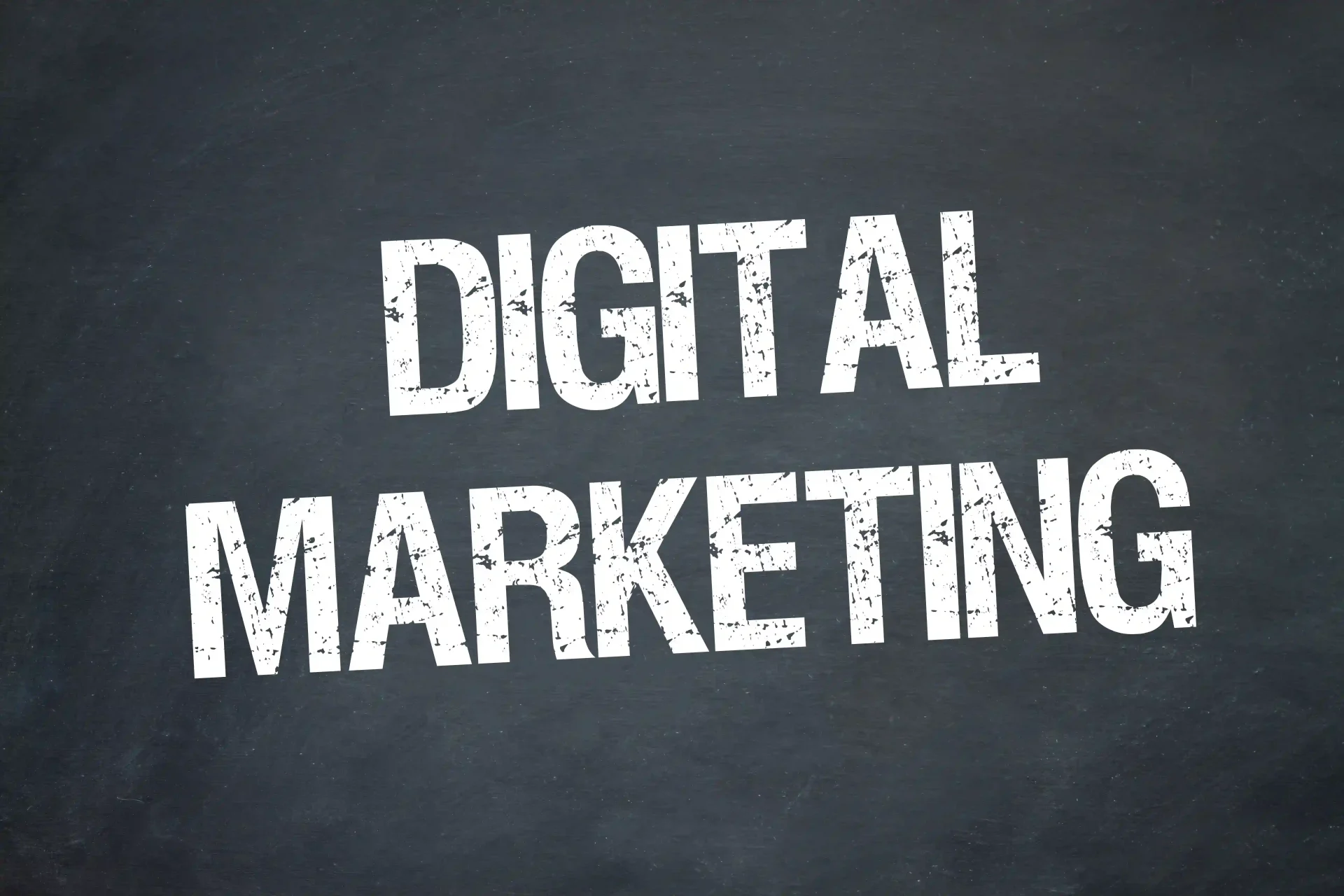
Difference between digital marketing and traditional marketing
Traditional marketing relies on offline channels, while digital marketing utilises digital channels. A conventional marketing campaign may involve billboards, print ads, and mailers. In contrast, a digital marketing campaign may leverage social media, blog posts, website content, and email to advertise a business brand and its products and services.
However, with the advent of technology, the line between traditional and digital marketing has started to fade, as even conventional channels like billboards, TV ads, and direct mail have incorporated a digital aspect into them.
The history of digital marketing
The emergence of digital marketing in the ’90s
The term “Digital Marketing” was first coined in the 1990s when the Internet began to gain popularity, and the first web platform was developed. While the Internet allowed users to find information, it did not initially provide a way to share information. This left marketers unsure about the effectiveness of their strategies since digital marketing was still new and untested.
In 1993, the first clickable banner was introduced, marking a shift toward digital marketing. The following year, new technologies were introduced, and Yahoo was established, receiving nearly a million hits within its first year. This led to significant changes in digital marketing, with businesses optimizing their websites for better search engine rankings.
In 1996, new search engines and tools like HotBot, LookSmart, and Alexa were launched, and two years later, Backrub was introduced, which later became Google. Microsoft launched the MSN search engine, and Yahoo introduced Yahoo Web Search. However, the Internet bubble burst in 2000, leaving more space for the giants in the business as smaller search engines were either left behind or wiped out.
In 2006, the digital marketing industry saw a significant surge when search engine traffic reportedly grew to about 6.4 billion queries monthly. Microsoft launched Live Search to compete with Google and Yahoo.
Web 2.0 and the Rise of Social Media Marketing
Web 2.0 allowed users to become more active participants than passive users, enabling them to interact with other users and businesses. As a result, information flow volumes, including channels utilized by digital marketers, increased dramatically. By 2004, Internet advertising and marketing in the US alone brought in around USD 2.9 billion.
The emergence of social networking sites, starting with Myspace and followed by Facebook, opened up new opportunities for companies to market their products and brands. This marked the beginning of a new chapter in the business world, prompting companies to adopt new approaches to capitalize on the social networking platform. With new resources, businesses needed innovative ways to promote their brands.
Another significant milestone in the digital marketing industry was the advent of the cookie, allowing advertisers to track frequent internet users’ browsing habits and usage patterns to tailor promotions and marketing materials to their target audience’s preferences. Cookies have evolved over the years, and today they offer marketers a range of options to collect detailed user data.
The fundamentals of digital marketing
Digital marketing involves using computing technology to execute marketing techniques through electronic devices, including online campaigns conducted on the Internet. Businesses can leverage various channels, such as websites, search engines, blogs, social media, videos, emails, and other platforms, to engage with current and potential customers.
Unlike traditional marketing, digital marketing is a dynamic process that offers a highway for two-way communication between businesses and actual or prospective customers.
Customers can’t interact with businesses through billboards or print ads. Digital marketing takes advantage of the reality that screen time is at an all-time high for many people, promoting business products and services across the Internet and targeting customers where they spend most of their time.
A successful digital marketing strategy, which can lead to significant commercial benefits, involves a combination of various methods, including online advertising, search engine optimization, search engine marketing, social media marketing and management, and content creation, among others, and it is suitable for both start-ups and enterprise businesses.

B2B vs. B2C digital marketing
Digital marketing strategies work for business-to-business B2B and business to consumer B2C companies. However, the way digital marketing is executed differs significantly between the two.
Below is how digital marketing is used in B2B and B2C marketing strategies.
- B2B clients have longer decision-making processes. Relationship-building strategies work better for these customers, whereas B2C customers respond better to short-term offers and messages.
- B2B transactions are usually based on logic and evidence. B2C content is more likely to be emotionally based, focusing on making the customer feel good about a purchase.
- B2B decisions need more than one person’s input. The marketing materials that best drive these decisions are shareable and downloadable. B2C customers favour one-on-one connections with a brand.
Although there are always exceptions to any rule, a B2C company with a high-value product may provide more informative and severe content. Thus, your digital marketing approach must be tailored to your customer base, regardless of whether you operate in a B2B or B2C industry.
Analyzing your current audience is crucial in creating a well-informed and targeted online marketing campaign. This approach will ensure your marketing efforts are practical and enable you to attract the attention of potential customers.
Why is digital marketing important?
Digital marketing has become increasingly important in the last 15 years due to the remarkable accessibility of digital channels. There are about five billion internet users globally, representing a significant portion of the world’s population. This widespread connectivity has revolutionized the way businesses and individuals interact, allowing people from diverse backgrounds, cultures, and geographic locations to come together on various digital platforms.
The accessibility of digital channels and the vast number of internet users worldwide have made digital marketing an essential aspect of business strategy. The seamless connectivity of various digital platforms enables businesses to reach and engage with a global audience. The digital landscape has genuinely transformed the way we communicate, connect, and conduct business, opening up endless possibilities for individuals and organizations alike.
Multiple online marketing strategies
Your business has an array of options to choose from when it comes to online marketing tactics. Digital marketing tactics encompass a broad range of techniques, including but not limited to:
- Search Engine Optimization (SEO)
- Pay-per-click advertising (PPC)
- Content marketing
- Conversion rate optimization (CRO)
- Social media marketing and advertising.
By choosing to implement digital marketing, your company can leverage various strategies. You have the flexibility to select the ones that best align with your business objectives and target market, thus maximizing the impact of online marketing on your overall profitability.
Cost-effective marketing solutions
Digital marketing offers the added advantage of cost-effectiveness. Compared to traditional marketing methods, online marketing is significantly more affordable. With online advertising, you can set your budget and bid for ad space on various platforms such as social media, websites, and search engines. This lets you to control your spending completely, which is impossible with traditional advertising mediums like billboards.
In addition, digital marketing campaigns offer great flexibility. Budgets and campaigns can be tailored to run for durations ranging from years to mere minutes. When combined with the ability to target specific audiences precisely, businesses gain unprecedented agility that is often absent in traditional campaigns.
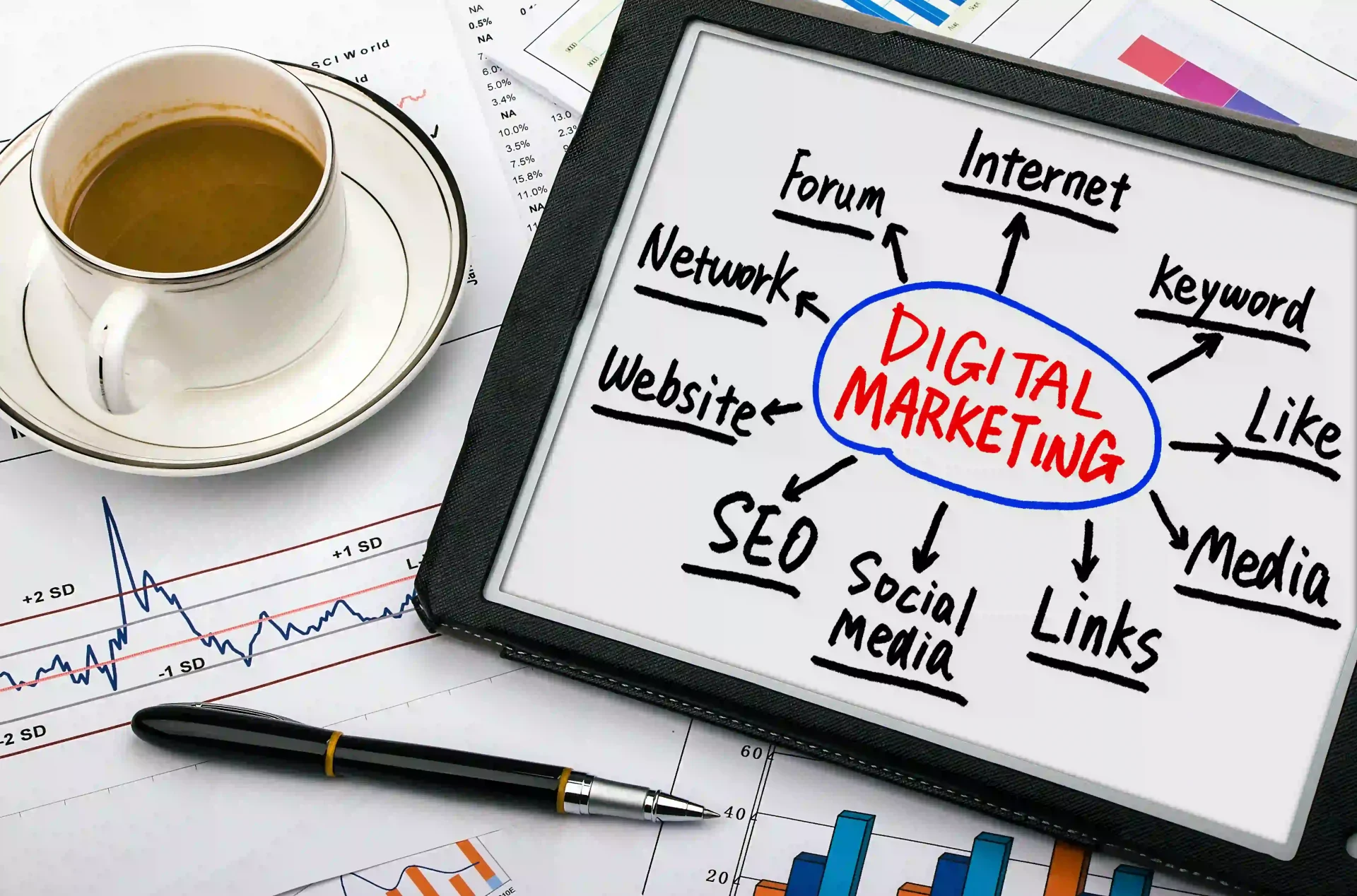
Advanced targeting and personalization options
Making online marketing a part of your business strategy also gives you access to a range of advanced targeting and personalization options.
Creating a personalized experience for users can lead to better marketing results. An email recommending products based on a subscriber’s past purchase behaviour can lead to another sale and even a word-of-mouth recommendation.
Accurate campaign tracking and measurement
Google tools like Google Analytics, Google Search Console and Google Ads make monitoring your strategy easy. Google Analytics allows you to track website traffic, user behaviour and website conversions. In comparison, Google Ads provides a 360-degree view of your PPC ads. These types of website analytics are integral to any digital marketing strategy.
You can use programs like Google Looker Studio to provide dashboards with compiled data into diagrams for transparency and easy access. Tools like these help you showcase, as well as analyse, the performance of online marketing.
Continuous campaign performance feedback
Digital marketing offers the advantage of obtaining real-time feedback on your marketing campaign’s performance.
For instance, if you launch a PPC campaign and make changes to your targeting that decrease conversions, you can quickly respond to the situation. You may undo the changes and return your campaign to its optimal performance.
With its various benefits, digital marketing can be a significant asset for businesses of all types and sizes.
The seven D’s of digital marketing
Unlike other advertising approaches, digital marketing allows you to reach and connect cost-effectively to a broad scope of areas. Another advantage of this, among many, is the ability to market the targeted offers, which, in turn, builds stronger customer loyalty.
The seven D’s deal with how audiences communicate and interact with a brand. Collectively they provide insights to implement marketing strategies better. In total, the seven D’s are composed of the different pillars of the electronic marketing world.
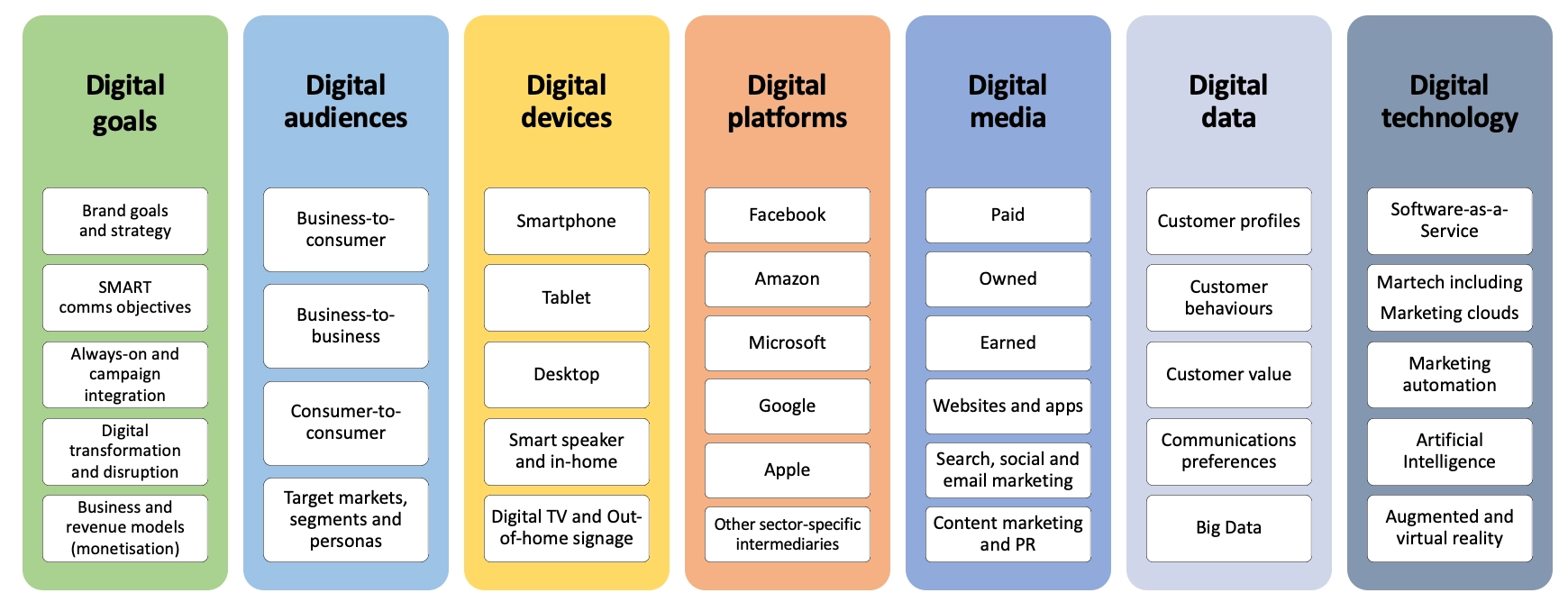
Image source: Dave Chaffey 2022
Digital goals
Defining the goals is about reviewing what the business or brand aims to achieve through digital marketing. Management considers how digital marketing can help the business compete through digital marketing strategy.
Digital audience
A prerequisite for effective online marketing is understanding the target audience’s characteristics, behaviors, and preferences to deliver more relevant content and experiences.
Digital devices
Digital devices are those that people use almost every day. Digital services can be accessed on different devices. Usually you can communicate with your target audience through computers, laptops, tablets and smartphones. However more and more inventions are being released, including Smart TVs, watches and gaming devices. These are used to interact with browsers, websites and applications online.
Digital content platforms
These are the platforms with which users interact regularly, such as social media. You can use them for advertising.
The wide range of digital platforms can be incorporated into digital marketing strategies in multiple ways. The first is to gain insights about target customers, such as their preferences and previous purchases. You can create your brand’s profile on an online platform, then use it to promote your products. To do so, share your offers and information about them in a way that can enthuse the audience to check out your label or website.
One efficient way to reach your audiences is to use social media platforms. While numerous browser sites and applications exist for that purpose, you should use popular ones to connect with more people.
Digital media
Paid or owned digital media channels can be used to reach your target audience. They include things like online advertising and social media marketing.
Digital media can significantly increase potential customers as more people hear about your brand and what you can offer.
There are various digital media to choose from. For instance, you can use the web and the search engine results to give attention to your brand. Mobile applications can also help drive sales. You can also utilize communication tools, such as messages or emails, for a more personalized approach.
Digital data
Digital data results from the three previous components. It comprises all the necessary and relevant information about your potential customers, which you can use to encourage them to purchase your products and services or, at the very least, check out your brand.
Data about your target audience used to achieve a marketing goal is called digital data. You can collect data about your target audience through surveys, apps, and other means.
The profile information will only contain publicly shared data and is permitted for spectator view. You can also see the organizations they are registered to, if there are any, and their engagements with other brands and businesses. It can be used to analyze their shopping patterns and preferences, which you can use to your advantage.
Digital technology
As a brand aiming for attention, you are encouraged to use modern technologies to communicate with your potential customers.
Digital technology is all about using technology to achieve a marketing goal. Artificial Intelligence AI, Augmented Reality AR, and Virtual Reality VR are a few examples.
These are possibilities you should evaluate could they bring opportunities to your marketing strategy.
Different types of digital marketing
There are as many specializations within digital marketing as there are ways of interacting using digital media. Here follows a few:
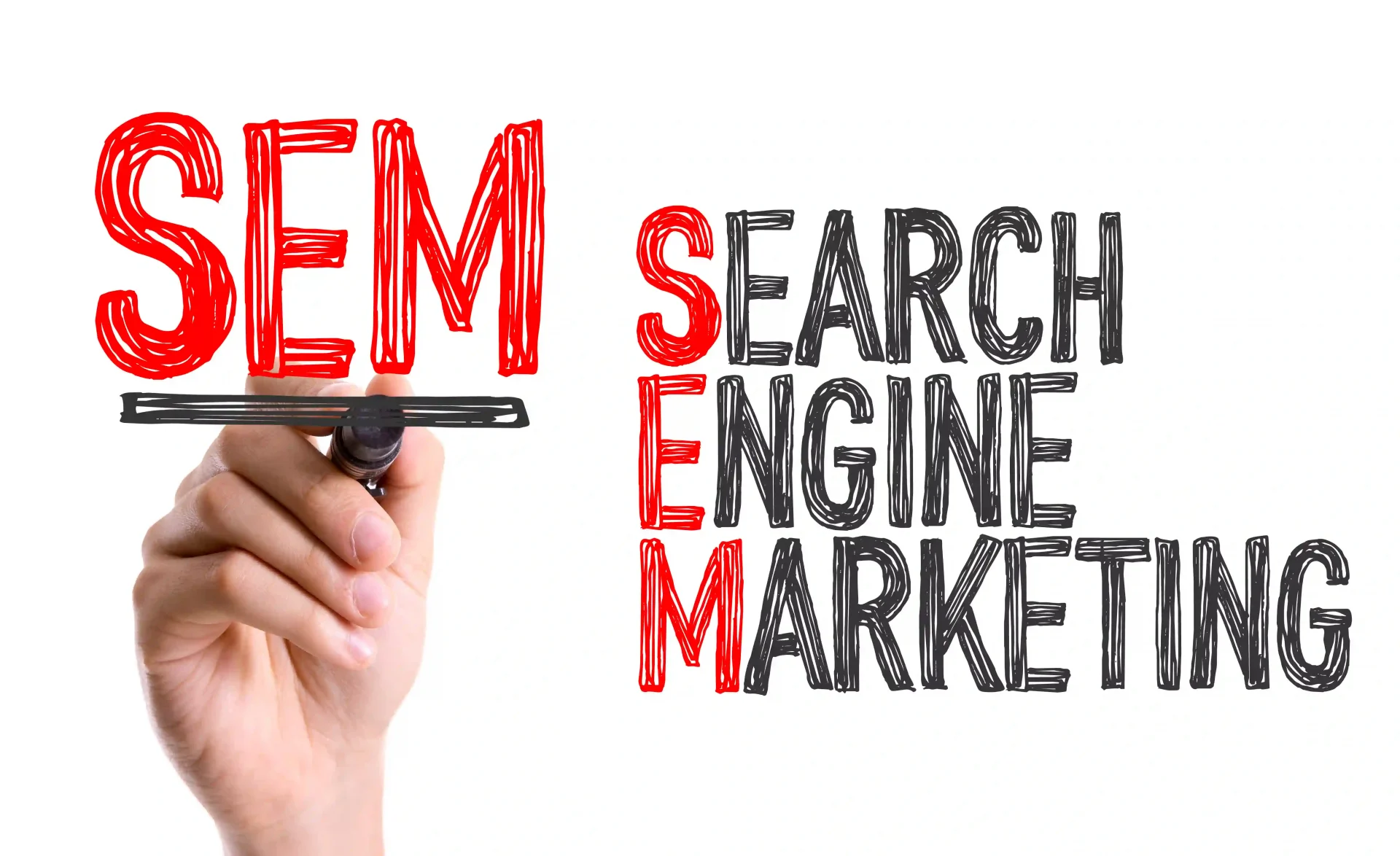
Search Engine Marketing SEM
Search engine marketing (SEM) includes all types of marketing that use search engines such as Google as their marketing tool. Search engine marketing typically encompasses two digital marketing strategies.
- Search Engine Optimization (SEO) is a technique that involves optimizing your website to enhance your search rankings and increase organic traffic. SEO comprises all actions taken to demonstrate to Google that your website is a reliable source of information, ultimately resulting in higher rankings for your desired search queries.
- Pay-per-click (PPC) advertising. PPC is another search engine marketing strategy that helps your business website appear on SERPs (search engine results). However, your website will appear in the paid search results section instead of organic results, located at the top or bottom of the SERP.
The main difference between SEO and paid advertising is that PPC requires you to pay per click while SEO focuses on organic traffic.
SEO involves “organic” ranking, which means you do not pay for your website to be in that space. Thus SEO refers to organic results as an outcome of providing relevant, useful content that ranks well on Google. On the other hand, PPC marketing is the strategy where marketers pay each time someone clicks their ad.
In recent years, SEM has become associated mainly with PPC and SEO has become its own separate strategy.
Content marketing
Content marketing is an approach in digital marketing that aims to produce informative and original content for users. This content may take various forms, including blog posts, videos, and online guides. It can be optimized for search engines, shared on social media, and promoted to increase reach and exposure.
This technique provides companies with a cost-effective and long-term strategy for connecting with, nurturing, and converting their target audience while supporting their SEO efforts. The quality of your content is a crucial aspect of an optimized page, so SEO plays a significant role in content marketing. This method centers on distributing valuable and relevant content to a particular audience.
The primary objective of content marketing is to attract leads that will eventually convert into customers, but it does so in a different way than conventional advertising. Instead of enticing prospects with potential product or service value, it provides value for free in the form of written materials such as blog posts, newsletters, white papers, E-books, and similar.
To develop compelling content that is highly relevant and engaging, it’s essential to determine your target audience. Whom are you attempting to connect with via your content marketing strategy? Once you better understand your audience, you can choose the type of content that will best meet their needs.

Blogging
Running a blog is one of the most popular ways to create content online. With user-friendly platforms like WordPress, starting a blog requires minimal investment. By sharing valuable information, blogging can help establish your brand, reputation, and authority in your industry.
Blogging lets you inform your potential customers by posting regular updates about timely issues in your industry. This approach helps answer your customers’ questions, educate them, and showcase your expertise, making it more likely that they will buy from you.
Publishing blog posts regularly encourages your readers to return to your site. It helps search engines like Google crawl your site more frequently, resulting in more visibility for your newest pages in search results.
Blogging is a practical, easy, and powerful way to build your brand online. That’s why it’s often the first content marketing strategy most companies adopt online.
Articles
Article pages are versatile pages on your website that can serve multiple purposes.
They are often utilized for:
- Displaying service pricing: Service pricing pages are beneficial in giving potential customers an idea of how much you charge for different service levels. This is especially advantageous for B2B sales.
- Providing product information: Product information pages are excellent for e-commerce sales as they provide customers with all the information they need to make an informed purchase.
- Categorizing e-commerce products: E-commerce category listings help to organize similar products into categories, which allows customers to browse for what they want.
Some businesses also use this format for FAQ pages, which is a great way to address many common questions all at once. In addition to these options, article pages can target long-tail keywords, providing long-term benefits even after publication.
This evergreen content can complement blog posts to create a comprehensive, well-rounded content strategy. By combining both approaches, you can target various keywords and drive traffic to your site daily.
Infographics
Infographics are graphical depictions of information that present a convincing argument using factual data. These visuals help simplify complex ideas and don’t need to be elaborate. Some of the most effective infographics consist of lists of data points with charts and graphs.
To generate ideas for infographics, consider how you can represent your products or services using data. This could involve displaying sales trends in your industry by year, showcasing the popularity of certain products, or illustrating the impact of various innovations.
Once you publish the infographic on your website, you can promote it on social media and obtain backlinks, which will help promote your brand to a broader audience.
Video
Video is an effective content medium that offers an engaging and user-friendly way to present information. Not only does video content provide a great user experience, but it can also help improve your search engine rankings and attract more traffic to your website.
By using videos, you can demonstrate to both users and search engines that you are a trusted source of information in your industry, which can help build your reputation and authority online.

How to use Content Marketing as a digital marketing technique
Use content marketing as a digital marketing technique with the following three tips:
Prioritise readers over search engines
Content marketing and SEO go hand in hand, and content marketing often involves SEO tactics. However, it’s crucial to avoid over-optimizing your content for search engines. Focus on creating content tailored to your target audience first and then optimize it for search engines. Avoid keyword stuffing that can harm your user experience and rankings.
Add helpful visuals
Visual content can enhance the user experience of your website. Videos, infographics, custom graphics, and other visuals can help your audience understand your content better and find answers to their queries. Adding multimedia to your content can improve user engagement, resulting in higher rankings in search results and more social media shares.
Conduct outreach to promote your content
Outreach involves creating compelling content on your website and sending it to other website owners to gain backlinks. This approach is different from influencer marketing because the primary objective of outreach is to improve your SEO.
Email is a valuable medium for outreach, where you can share your content and request them to repost it on their site while giving you credit for the original piece. Backlinks play a vital role in SEO, and having many high-quality backlinks from reputable websites signifies trust and authority.
This helps Google rank your site higher in search results, increasing the potential for more organic traffic and leads.
Social media marketing
Social media marketing is a digital marketing approach that aims to increase brand awareness and website traffic by utilizing social media networks to engage with the target audience. As billions of people worldwide spend significant time on social media platforms, it is crucial to consider social media marketing for your business.
The most popular social media platforms for marketing include Facebook, Instagram, Twitter, LinkedIn, YouTube, TikTok, and Pinterest. However, the choice of platforms depends on the company’s goals and target audience.
Social media marketing offers various engagement metrics that can be utilized to evaluate the effectiveness of a marketing campaign. Brands can choose their website’s most meaningful interactions, such as shares, comments, or clicks.
Many companies employ social media marketing to establish conversations with their audience instead of urging them to make immediate purchases. This is particularly prevalent in brands that target older audiences or provide products and services that are unsuitable for impulse buys. Ultimately, social media marketing tactics should align with a company’s specific goals for the campaign.
To create an effective social media marketing strategy, it’s crucial to follow best practices. Here are a few of the most important social media marketing practices:
- Craft high-quality and engaging content
- Reply to comments and questions in a professional manner
- Create a social media posting schedule
- Post at the right time
- Hire social media managers to support your marketing efforts
- Know your audience and which social media channels they’re most active on
While some marketers view social media marketing as a component of content marketing, others consider it an effective marketing strategy and believe it should receive more recognition.
Leveraging social media for marketing is an affordable means of engaging with your audience, providing information to potential customers, and ultimately boosting the sales of your products or services.
In the following are described seven social media platforms often used in marketing.
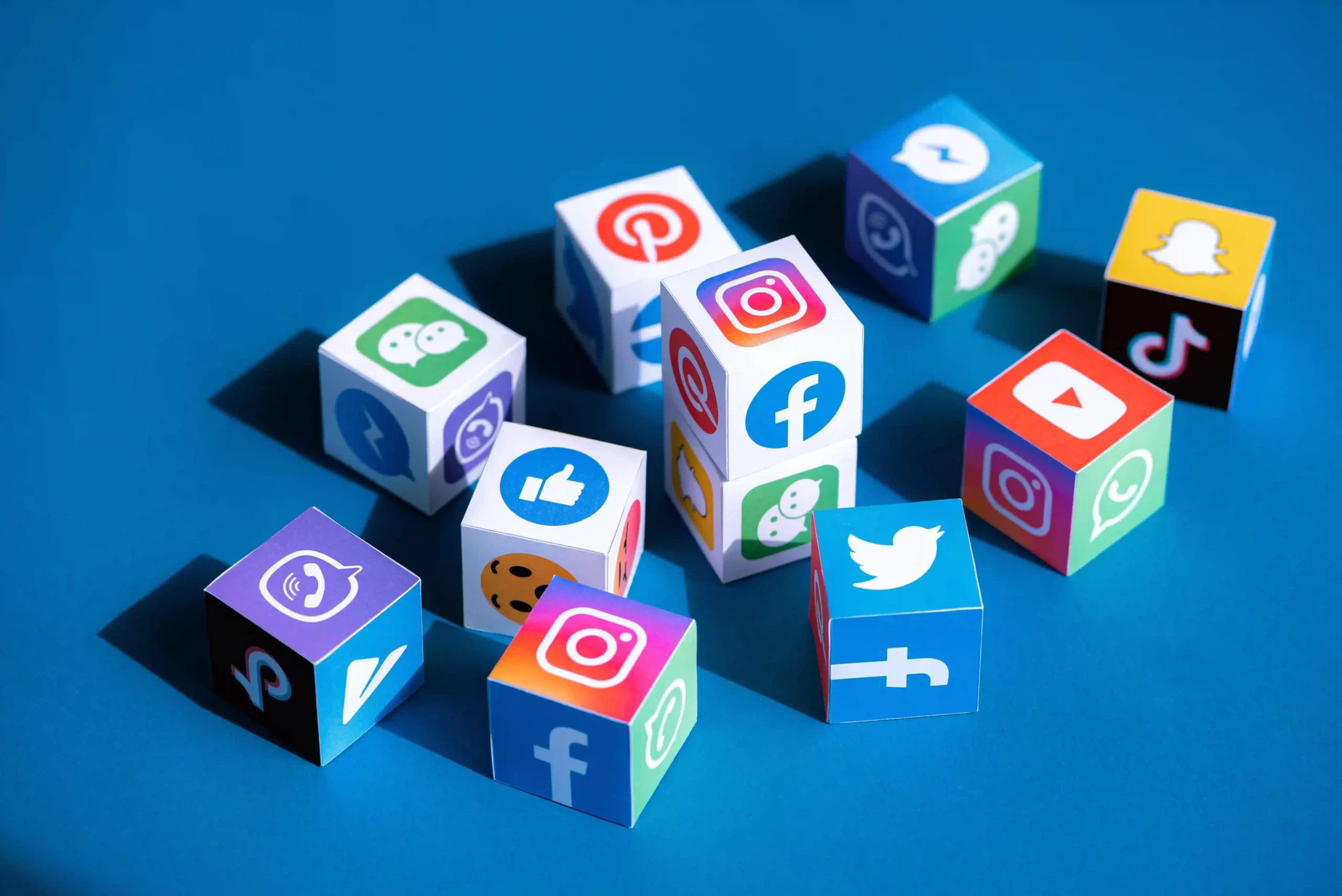
With over one billion users, Facebook is the world’s most popular social network, making it an excellent platform to find potential customers for your business.
You can easily set up a business page for free, optimize it quickly, and use it to post updates from your website, contests for followers, and other engaging content that can also help with your local SEO strategy.
Instagram is a platform that allows you to engage with your audience using visually appealing images and videos, including limited-time Instagram Stories. By uploading product or service images and tagging them as shoppable products, you can make it easier for your followers to go from browsing social media to purchasing your products.
x (former Twitter)
X (former Twitter) is one of the most significant social networks that limit users to 280-character tweets that may include images and links. You can quickly gain followers by tweeting links to content, industry news, and exciting stories.
X is also an ideal customer service platform, allowing customers to communicate easily with companies. When addressing customer questions or concerns professionally, you can use X to improve your company’s reputation.
LinkedIn is the world’s largest professional social network, making it an important online meeting place for professionals. You can use LinkedIn for marketing by posting links to your site, participating in discussions, and showing that your business strives for excellence.
Creating a business page on LinkedIn allows you to provide vital information about your company and share updates with followers.
LinkedIn’s professional context makes it ideal for establishing new business relationships and promoting your company to potential customers.
YouTube
YouTube is a video-sharing platform that enables users to view, like, share, comment, and upload their videos. The video-sharing service is accessible via personal computers, laptops, tablets, and mobile phones. Read more about YouTube advertising here!
YouTube is the internet’s second largest search engine and is an efficient way can help to improve your SEO and overall brand presence. YouTube allows you to present unique content that’s easy for viewers to consume and share.
YouTube marketing combines SEO a strategic principle with the video concept.
TikTok
TikTok is a short-form, video-sharing app that allows users to create and share 15-second videos, on any topic.
TikTok does not have any space for traditional display ads and is not even in competition with other social media platforms, in terms of it being a marketing channel. However, due to its fast growth and rising popularity, many brands are now realizing the potential of TikTok as a marketing channel.
Several brands have utilized techniques like TikTok challenges and contests to get users to generate brand-related content. Brands are also leveraging hashtags, in a similar fashion as on other social media platforms, to promote their TikTok marketing campaigns.
Pinterest is one of the Internet’s most popular social networks. Pinterest lets you share images of your team, the results of your work, and how your products work, among other opportunities.
This allows you to inform your customer base more effectively than you could with text alone. This is the same principle behind infographics and videos which is why Pinterest is such an effective social network for marketing.

How to use SoMe Marketing as a digital marketing technique
While creating a business page on every social media platform can be beneficial, focusing your social media marketing efforts on the networks your target audience uses the most. For example, if your audience isn’t active on Twitter, it may not be worth dedicating much time to that platform.
In general, most businesses will benefit from having a Facebook and LinkedIn account. You’ll need to research your audience for other social media networks to determine where they spend their time online. Rather than constantly promoting your business and products, create content that will capture your audience’s attention and offer them value. This could be a helpful blog post, poll, or customer testimonial.
Email marketing
Email Marketing is a powerful type of digital marketing that many companies use due to its high effectiveness. This technique involves sending emails to customers and prospects to increase sales and help guide them through the sales funnel. With high conversion rates come high returns.
What is email marketing
Email marketing is a digital marketing technique that generates and nurtures leads by sending various emails. These emails can be used to promote products, share company announcements, and offer helpful advice or articles.
One crucial aspect of email marketing is building an email subscriber list, which allows businesses to send targeted emails and drip campaigns, such as new product releases, abandoned cart reminders, and newsletters, to help guide customers through the sales funnel.
Newsletter
Newsletters are emails sent to an extensive list that provide general information about a company or industry. They are ideal for people in the industry who want to stay informed about what’s happening and show that the business is an authoritative resource in its sector.
Newsletters are sent out regularly and can include important company news, curated industry news from the internet, and other relevant information showcasing the business’s expertise and helpfulness.
How to use email marketing as a digital marketing technique
Email marketing is a digital marketing technique that focuses on generating and nurturing leads. With email marketing, businesses can send a range of emails, including to promote products, share company announcements and pass along helpful advice or articles.
Creating segmented audiences
If you want to increase your revenue through email marketing, segmenting your subscribers into dedicated audiences can be highly effective. You can segment your subscribers based on their interests, actions, locations, etc. By doing so, you can provide them with more personalized and relevant emails.
Perform testing
Testing is a valuable tool in digital marketing that can help you discover new insights about your audience and enhance your overall strategy. Adopting an “always be testing” attitude towards your email marketing strategy can help you test elements like:
- Subject lines
- Email content
- Type of images
- Send times
With regular testing, you can build a list of actionable takeaways that can be applied to your email marketing and overall digital marketing strategies.
A/B testing, split testing or bucket testing, is a technique used to compare two versions of a website or application to determine which one performs better. Essentially, A/B testing involves conducting an experiment in which randomly selected users are shown two or more page variants and then using statistical analysis to determine which variant performs better in achieving a specific conversion goal.
By comparing a variation against the everyday experience, A/B testing enables focused questioning about website or app changes and data collection on the impact of those changes.
Testing eliminates the guesswork in website optimization and facilitates data-driven decisions, shifting business discussions from “we think” to “we know.” With metrics measurement, every change can produce positive results.
Personalize email
To ensure that your emails are wanted, it’s essential to have an opt-in list that individualizes the content, states clearly what type of emails the subscriber will receive, offers an email signature with an unsubscribe option, and integrates both transactional and promotional emails.
Personalization is a helpful technique in email marketing that can help you personalize emails with a subscriber’s name, purchase history, shopping cart, and more.
Video marketing
Video marketing is a digital marketing technique that employs videos to entice, involve, instruct, and convince viewers. Videos can be used by companies on their website, as well as video hosting sites such as YouTube. Videos can be different, ranging from product showcases and vlogs to testimonials.
Video marketing is a valuable digital marketing technique for businesses, with 90% of users claiming that videos help them make purchase decisions. You can also integrate video into other online marketing strategies, such as email and content marketing.

Optimizing your videos for optimal results with video marketing is essential for search engine optimization (SEO). If you upload your videos to YouTube, you should follow YouTube’s SEO best practices, such as using targeted keywords in your video title, adding relevant video tags, and creating custom thumbnails.
Read more in detail about working with Youtube video advertising!
You can also utilize YouTube SEO services to optimize and rank your video content on YouTube. Above all, focus on your content’s quality, ensuring that your video provides value to your audience. By responding to questions without getting sidetracked, you can build trust, respect, interest, and enthusiasm in sharing your videos with your audience.
Affiliate Marketing
Affiliate marketing is a practice based on performance that allows revenue sharing and pay-per-sale compensation within a shared network. It enables an individual to earn money by promoting another person’s business. Whether you are a promoter or a business owner who collaborates with a promoter, the process remains the same.
This marketing method operates on a revenue sharing model. If you are an affiliate, you earn a commission every time someone purchases the item you are promoting. If you are a merchant, you compensate the affiliate for every sale they help generate.
While some affiliate marketers review a single company’s products, others work with multiple merchants. The first step is to connect with the other party to become an affiliate or find one. There are digital channels available to link affiliates with retailers, or you can participate in a single-retailer program.
Influencer marketing
Influencer marketing, like affiliate marketing, is a digital marketing technique that involves collaborating with individuals who have a significant following on social media platforms in exchange for exposure.
Typically, these individuals endorse products or services to their followers across various social media channels.
Working with trustworthy influencers is crucial as they represent your brand. An untrustworthy influencer can negatively impact the credibility of your business in the eyes of consumers.
Some people view influencer marketing as social media marketing, while others consider it a distinct approach. With influencer marketing, companies can take advantage of the relationships that influencers and thought leaders have built with their audiences.
The benefits of digital marketing
Connect with the right audience, in the right place, at the right time
Having an online presence provides a broader reach to potential customers. By utilizing digital marketing, businesses can reach more of the right audience than traditional offline marketing. By doing so effectively, companies can connect with potential customers at the most opportune time in their buyer’s journey.
Obtain measurable results to refine your strategy
One of the key benefits of digital marketing is that it provides accurate and real-time results. Through analytics software, marketers can measure any aspect of their marketing efforts’ return on investment (ROI). This data provides invaluable insights into the performance of marketing tactics and enables marketers to take corrective actions when necessary.
With tools such as Google Analytics and Google Search Console, marketers can track the performance of their digital marketing campaigns from start to finish.
Reaching a global audience
You can reach a larger audience in a shorter time. Technological advances have resulted in people have moved on to tablets, phones, and computers, which are the areas where digital marketers have gained the most ground.
This also means that digital marketing has removed all sorts of geographical barriers. You can reach your audience globally easily and create awareness among people who otherwise had no chance of knowing about your existence.
Increased ROI
The extensive reach offered by digital marketing makes the costs comparatively affordable. The ROI on digital marketing efforts is considerably higher than traditional marketing, which allows small-scale businesses to make optimum use of digital marketing without causing hefty stress on budgets.
Improved conversion rates
With the help of tracking the performance, you can assess where your maximum sales come in from and accordingly target consumers. This means higher conversion rates as you invest where you are in demand. With digital marketing you will understand where the lead converted from and thus you will not waste your time on the wrong leads.
Interactive marketing
Digital Marketing is all about two-way interaction. Brands interact with their target audience through various digital marketing campaigns to portray their uniqueness. Customers interact, engage, and express their interest in that particular brand.
Improved customer experience
Winning your customer’s loyalty is the ultimate win for your company. A loyal customer is the best marketer for your business. With digital mediums, reaching out to interested customers or concerned about your solutions is a lot easier.
Higher engagement
Social media marketing provides businesses to post interactive content, engage with customers and answer their queries.
Customers highly appreciate that companies listen to them and respond to them effectively. They prefer brands that value their voice.
With the help of social media management and marketing, as a business you can effectively communicate with potential customers and build your relationship and reputation.
Your content goes here. Edit or remove this text inline or in the module Content settings. You can also style every aspect of this content in the module Design settings and even apply custom CSS to this text in the module Advanced settings.
Summary
Digital marketing has become increasingly important in the last 15 years due to the remarkable accessibility of digital channels. There are five billion Internet users globally, representing a significant portion of the world’s population. This widespread connectivity has revolutionized the way businesses and individuals interact.
The accessibility of digital channels and the vast number of internet users worldwide have made digital marketing an essential aspect of business strategy. The seamless connectivity of various digital platforms enables businesses to reach and engage with a global audience.
Digital marketing provides numerous ways to connect with your target audience. It encompasses various techniques, including SEO, PPC, content marketing, CRO, and social media marketing and advertising, providing businesses with multiple strategies.
The benefits of digital marketing include:
- Connecting with the right audience
- Obtaining measurable results to refine strategy
- Reaching a global audience
- Increased ROI
- Improved conversion rates
- Interactive marketing
- Better customer experience
- Higher engagement
The sooner you explore, learn, and take advantage of the full potential of digital marketing, the sooner you will leap over those competitors who don’t spend time and energy executing efficient digital marketing.
Let’s make your solutions visible!
Let's work together to create a successful online presence for your website and boost your online marketing activities that brings real results for the visibility of your solutions and enhance your brand.
I offer services in the below areas. Click the links to learn more.

Contact me and let's discuss your questions, concerns and needs in any aspects in the above areas!
